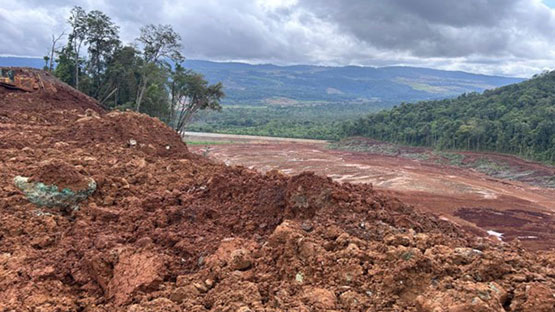June 2024 Issue Index
Creating accurate waste dump designs
PT Vale employs Maptek Vulcan for waste dump design at a nickel laterite operation on the island of Sulawesi in Indonesia.
Vale is a global mineral mining company whose subsidiary PT Vale Indonesia Tbk (PTVI) is committed to contributing to Indonesia’s sustainable development. PTVI has several mine sites on the island of Sulawesi: Sorowako, Bahodopi and Pomalaa. The operation in Sorowako uses open cast methods to mine nickel laterite ore.
Maptek Vulcan software has been used by PTVI for many years.
The mining engineers use Vulcan to create top-down waste dump designs that follow the natural shape of the overburden material being dumped at the disposal location. Design considerations include topographical contour and material angle of repose. The aim is for the design to match the actual waste dump that is being progressively created.

The design process begins with a closed polygon as the top surface of the final waste dump design. This surface (string) is projected downward with a particular batter angle and projection distance. Standard corporate practice is to manually determine the batter angle by looking at the topographic shape. Level-by-level projection is done at 10-metre intervals.
Projection of the top surface is carried out continuously until the final string is completely buried under the topography. A surface triangulation of the waste dump layer is then intersected with the topography.
This design approach is ideal as it closely follows the actual shape of the dump and the top-down dumping method used on site.
Creating a dump design similar to the as-built provides a higher level of accuracy for the planning process.
‘We can estimate the capacity of the dump and the flow direction of the material being delivered to the disposal area, allowing us to prevent unwanted flow if necessary,’ explained PTVI Mining Engineer, Andrew Christian.
‘We can also calculate the maximum dumping limit position at the disposal area following geotechnical assessment, water ponding and hydrological issues at the waste dump area,’ he added.
The design can be easily converted to a .dxf extension file for transfer to other teams for their specific geotechnical, hydrological and reclamation needs. In addition, the design can be subtracted from the topographic surface updated weekly.
The value gained from this method is demonstrated by the accuracy of the estimated dump capacity against the actual capacity. If designed properly with the correct projection angles and distances and following the topographical shape, design capacity should be within 80-90% of the actual dump.
Further automating the design process can greatly reduce the time to determine the batter angle of every projection. Maptek looks forward to working with PT Vale to help them generate designs that closely match the as-built dump.
Thanks to
Andrew Christian
Mining Engineer
PT Vale, Sorowako
- Top-down waste dumps are designed to follow the natural shape of the overburden material at the disposal location
- Estimating dump capacity and direction of material flow allows the engineering team to prevent unwanted flow if necessary
- Designs can be easily passed to other teams for application to geotechnical, hydrological and reclamation work

